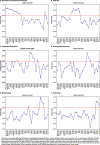Natural clusters of tuberous sclerosis complex (TSC)-associated neuropsychiatric disorders (TAND): new findings from the TOSCA TAND research project
- PMID: 32873244
- PMCID: PMC7465404
- DOI: 10.1186/s11689-020-09327-0
Natural clusters of tuberous sclerosis complex (TSC)-associated neuropsychiatric disorders (TAND): new findings from the TOSCA TAND research project
Abstract
Background: Tuberous sclerosis complex (TSC)-associated neuropsychiatric disorders (TAND) have unique, individual patterns that pose significant challenges for diagnosis, psycho-education, and intervention planning. A recent study suggested that it may be feasible to use TAND Checklist data and data-driven methods to generate natural TAND clusters. However, the study had a small sample size and data from only two countries. Here, we investigated the replicability of identifying natural TAND clusters from a larger and more diverse sample from the TOSCA study.
Methods: As part of the TOSCA international TSC registry study, this embedded research project collected TAND Checklist data from individuals with TSC. Correlation coefficients were calculated for TAND variables to generate a correlation matrix. Hierarchical cluster and factor analysis methods were used for data reduction and identification of natural TAND clusters.
Results: A total of 85 individuals with TSC (female:male, 40:45) from 7 countries were enrolled. Cluster analysis grouped the TAND variables into 6 clusters: a scholastic cluster (reading, writing, spelling, mathematics, visuo-spatial difficulties, disorientation), a hyperactive/impulsive cluster (hyperactivity, impulsivity, self-injurious behavior), a mood/anxiety cluster (anxiety, depressed mood, sleep difficulties, shyness), a neuropsychological cluster (attention/concentration difficulties, memory, attention, dual/multi-tasking, executive skills deficits), a dysregulated behavior cluster (mood swings, aggressive outbursts, temper tantrums), and an autism spectrum disorder (ASD)-like cluster (delayed language, poor eye contact, repetitive behaviors, unusual use of language, inflexibility, difficulties associated with eating). The natural clusters mapped reasonably well onto the six-factor solution generated. Comparison between cluster and factor solutions from this study and the earlier feasibility study showed significant similarity, particularly in cluster solutions.
Conclusions: Results from this TOSCA research project in an independent international data set showed that the combination of cluster analysis and factor analysis may be able to identify clinically meaningful natural TAND clusters. Findings were remarkably similar to those identified in the earlier feasibility study, supporting the potential robustness of these natural TAND clusters. Further steps should include examination of larger samples, investigation of internal consistency, and evaluation of the robustness of the proposed natural clusters.
Keywords: ASD; Cluster analysis; Factor analysis; Natural TAND clusters; Neuropsychiatric; Registry; TAND; TOSCA; Tuberous sclerosis complex.
Conflict of interest statement
PJdV, EB, TC, VC, PC, GBd’A, JCK, JCF, MF, CF, CH, SJ, RN, FO’C, JQ, MS, RT, JAL, AM, SY, MPB, BZ, and ACJ received honoraria and travel support from Novartis. VC received personal fees for consulting; lecture fees and travel from Actelion, Bayer, Biogen Idec, Boehringer Ingelheim, Gilead, GSK, MSD, Novartis, Pfizer, Roche, and Sanofi; grants from Actelion, Boehringer Ingelheim, GSK, Pfizer, and Roche; and personal fees for developing educational material from Boehringer Ingelheim and Roche. PJdV has been on the steering group of the EXIST-1, 2, and 3 studies sponsored by Novartis and co-PI on two investigator-initiated studies part-funded by Novartis. RN received grant support, paid to her institution, from Eisai and lecture fees from Nutricia, Eisai, Advicenne, and GW Pharma. YT received personal fees from Novartis for lecture and for copyright of referential figures from the journals and grant from the Japanese government for intractable epilepsy research. SJ was partly financed by the EC Seventh Framework Programme (FP7/2007-2013; EPISTOP, grant agreement no. 602391), the Polish Ministerial funds for science (years 2013–2018) for the implementation of international co-financed project, and the grant EPIMARKER of the Polish National Center for Research and Development No. STRATEGMED3/306306/4/2016. JCK, PC, CH, JAL, and JQ received research grants from Novartis. RM and SS are employees of Novartis. LD’A was an employee of Novartis at the time of manuscript concept approval. VS reported no conflict of interest.
Figures





